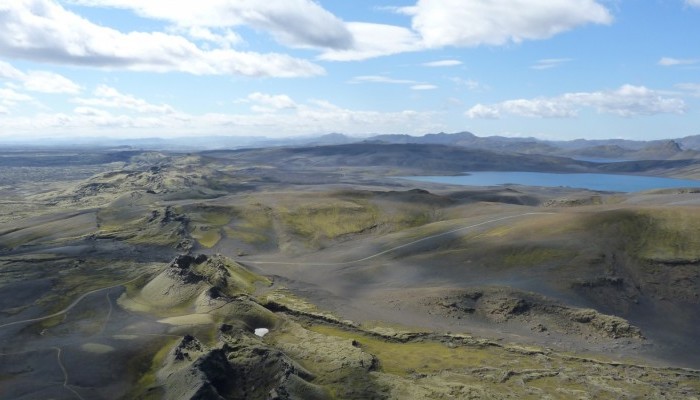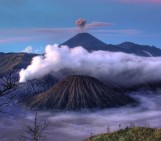
It’s hard to think of the scale of the biggest air pollution event in the modern era. Immediately my mind conjures up memories of black and white photographs of the Great London Smog of 1952. Then I start thinking bigger, how about the 1.2 billion vehicles world-wide on the road churning out nitrogen dioxide every single day? Well these are a drop in the ocean compared with bigger industrial polluters. A recent study by the World Health Organisation pegged the financial damage to Europe by anthropogenic air pollution in 2010 at a whopping €2 Trillion. However all of these anthropogenic pollution events pale in comparison compared with mother Earth. A single volcano, Mt. Etna in Sicily has been known to emit the same amount of sulphur in a year as all of French industry.
So, perhaps we just need to find the biggest volcanic eruption in the modern era? This is the 1815 Tambora eruption, the biggest in the last 10,000 years. Actually, no – how explosive a volcanic eruption is and the amount of potentially harmful sulphur dioxide it emits are not always related and even then the dangers these pose to humans depend on weather conditions. In the modern era there is one natural contender: pumping out 15 times more sulphur as the whole European region in 2010, the 1783 volcanic eruption of Laki.
The eruption carried gases into the atmosphere to the start of the tropopause. This is not abnormal, the 2010 eruptions of Eyjafjallajökull followed the same path. What was different from other eruptions was the amount of gas. The Laki eruption carried an estimated 8 million tons of poisonous hydrofluoric acid and 120 million tons of sulphur dioxide into the atmosphere. Here the gases entered the jet stream; a narrow band of intense winds found at about 16 km altitude and this had far-reaching effects.
A high pressure area over Iceland at the time of the eruption caused the poison ridden winds to move south-east and subside over Europe. This resulted in many thousands of deaths because sulphur dioxide gas reacts with moisture in lungs to form sulphurous acid.
High pressure blocking over Iceland (top-left) during Laki eruption caused eruption clouds to move over Europe. Image adapted from: Thordarsson and Self (2003).
The ‘Laki haze’ did not dissipate due to hot weather until the autumn and acted like a heat blanket creating convection from increased surface heating resulting in thunderstorms. This directly led to severe flood damage in central Europe. Crop and livestock damage followed. A famine began in Iceland where most of the livestock died from skeletal fluorosis; a condition caused by ingesting fluoride which leads to decreased bone strength, increased risk of fractures and impaired mobility.
This one event weakened the African monsoon circulation leading to less precipitation over the Sahel and resulting in an Egyptian famine due to a shortage of water in the Nile. The Chalisa famine in India occurred also the same year and resulted in 11 million deaths on the subcontinent. However the second of these famines can also be linked to changing El-Niño conditions over the preceding years. The volcanic eruption gases on the atmosphere were as far reaching as North America where there was reported to be ice in the Gulf of Mexico.
A cycle of unusual seasons continued for several years after and caused huge global economic hardship which has been thought to be one of the drivers behind the French Revolution. The large amounts of Sulphur dioxide that remained in the atmosphere may have caused global average temperatures to fall by 1°C for the next couple of years. About 6 million people died as a result of the eruption, either directly or indirectly – this was about 1% of the world’s population at the time.
The Laki 1783 eruption is troubling. In the popular imagination big explosive volcanic events are the most devastating and cone shaped volcanos like Krakatoa are more embedded in our consciousness. However a lesser-known less explosive volcano, if well placed in terms of weather patterns, could potentially be more devastating. If an event like the Laki eruption were to happen again we could expect cold weather and maybe a year without summer. Modern volcanic monitoring practises could help us prepare for such an event but its global nature would still be very disrupting to our lives.



Trent Bowen
This is really scary about the deaths in Iceland! I had no idea that this could happen… Surely there could have been a way to predict the reaction the lungs would have to sulphur dioxide to give people time to prepare themselves.
Claudia Wieners
@ Trent Bowen: The deaths in Iceland after the Lakagígar eruption were mainly due to famine and infectious diseases, and NOT sulfur poisoning. It is not known what exactly these diseases were; it could be that people succumbed to normally harmless illnesses because of being weakened by hunger.
The reason for the famine, as Webb mentioned, was the death of livestock due to fluorine poisoning and also damage to vegetation by acid rain (reduced hay harvest). The famine was made worse by inadequate policy in Denmark, of which Iceland was a dependency at that time. (I wrote a article about this aspect, which will be uploaded at the GMPV division blog next week)
Mortality in Iceland only increased in the winter 1783/84, i.e. 1/2 year after the onset of the eruption. If sulfur poisoning had been a main cause for human mortality in Iceland, one would expect mortality to rise already during the eruption (similarly to the Great London Smog, where mortality jumped up during polluted days, although the decline in mortality rate lagged behind the decline in pollution). The people in Iceland did suffer considerable discomfort from sulfur emissions, such as irritate eyes and skin and difficult breathing, but did not massively die from this effect. People started dying when they had no food left.
This makes it at least questionable whether indeed thousands of people died in Europe due to sulfuric haze in the summer 1783, as was suggested by Grattan et al. After all, the haze did not cause massive death in Iceland where the concentrations must have been higher, so why would the English and French die from it? Clive Oppenheimer suggests that the death in England and maybe France may have been caused by a fever epidemic, possibly related to the extreme summer heat which may have favoured disease-spreading mosquitoes.
Finally, it is not so clear whether the Lakagígar eruption was the cause for the extreme summer heat in Europe in 1783. If the haze caused a “heat blanket” there, then how can it be explained that Iceland and also the Farøer experienced cold conditions, as Thordarson and Self (2003) point out? The same paper suggests that the heat may have been caused by a persistent high pressure area over Europe (maybe a bit like in 2003; see also the other weather map in Thordarson and Self, which is not reproduced in this blog article).
A lot of aspects concerning the Lakagígar eruption are more subtle and more uncertain than one would first think. One should be careful with attributing all anomalies that happened during or shortly after 1783 to the volcanic activity.
Claudia Wieners
@ Trent Bowen: The deaths in Iceland in the 2 years after the Lakagígar eruption were mainly due to famine and infectious diseases, and NOT sulfur poisoning. It is not known what exactly these diseases were; it could be that people succumbed to normally harmless illnesses because of being weakened by hunger.
The reason for the famine, as Webb mentioned, was the death of livestock due to fluorine poisoning and also damage to vegetation by acid rain (reduced hay harvest). The famine was made worse by inadequate policy in Denmark, of which Iceland was a dependency at that time. (I wrote an article about this aspect, which will be uploaded at the GMPV division blog next week.)
Mortality in Iceland only increased in the winter 1783/84, i.e. 1/2 year after the onset of the eruption. If sulfur poisoning had been a main cause for human mortality in Iceland, one would expect mortality to rise already during the eruption (similarly to the Great London Smog, where mortality jumped up during polluted days, although the decline in mortality rate lagged behind the decline in pollution). The people in Iceland did suffer considerable discomfort from sulfur emissions, such as irritate eyes and skin and difficult breathing, but did not massively die from this effect. People started dying when they had no food left.
This makes it at least questionable whether indeed thousands of people died in Europe due to sulfuric haze in the summer 1783, as was suggested by Grattan et al. After all, the haze did not cause massive death in Iceland where the concentrations must have been higher, so why would the English and French die from it? Clive Oppenheimer suggests that the death in England and maybe France may have been caused by a fever epidemic, possibly related to the extreme summer heat which may have favoured disease-spreading mosquitoes.
Finally, it is not so clear whether the Lakagígar eruption was the cause for the extreme summer heat in Europe in 1783. If the haze caused a “heat blanket” there, then how can it be explained that Iceland and also the Farøer experienced cold conditions, as Thordarson and Self (2003) point out? The same paper suggests that the heat may have been caused by a persistent high pressure area over Europe (maybe a bit like in 2003; see also the other weather map in Thordarson and Self, which is not reproduced in this blog article).
A lot of aspects concerning the Lakagígar eruption are more subtle and more uncertain than one would first think. One should be careful with attributing all anomalies that happened during or shortly after 1783 to the volcanic activity. Still, it probably holds that a Lakagígar-like eruption, if it were to happen again, would have widespread effects beyond Iceland.